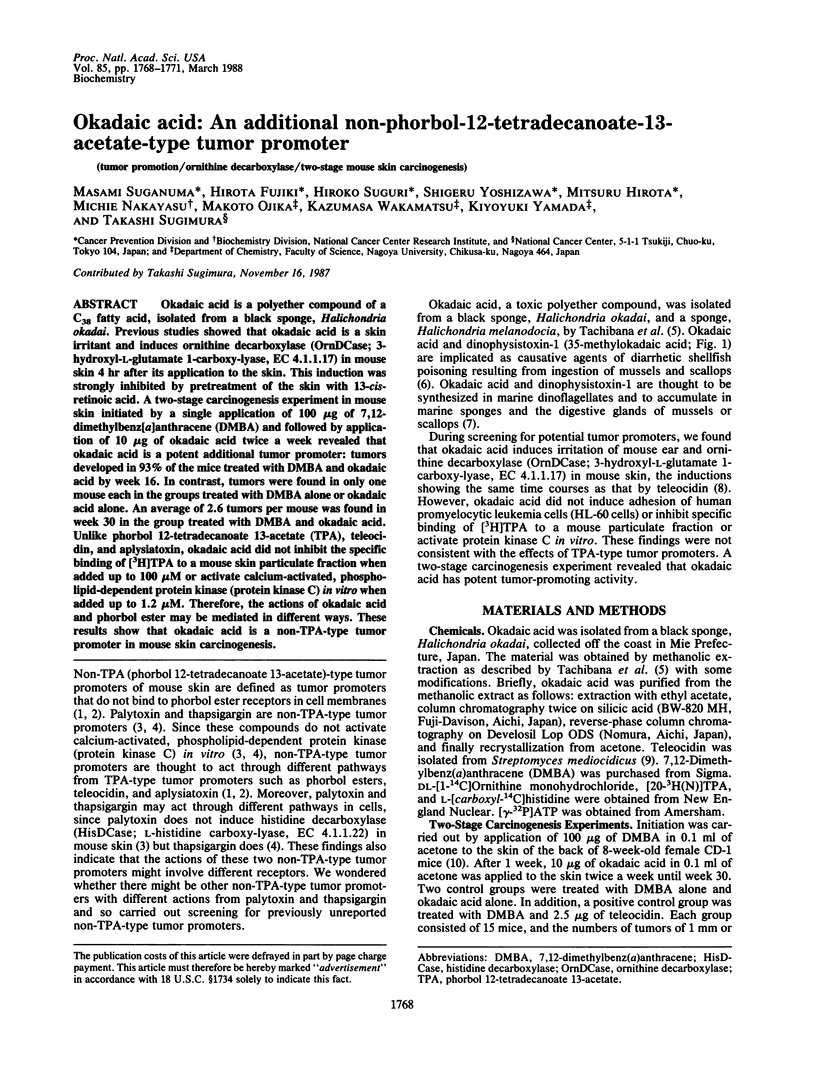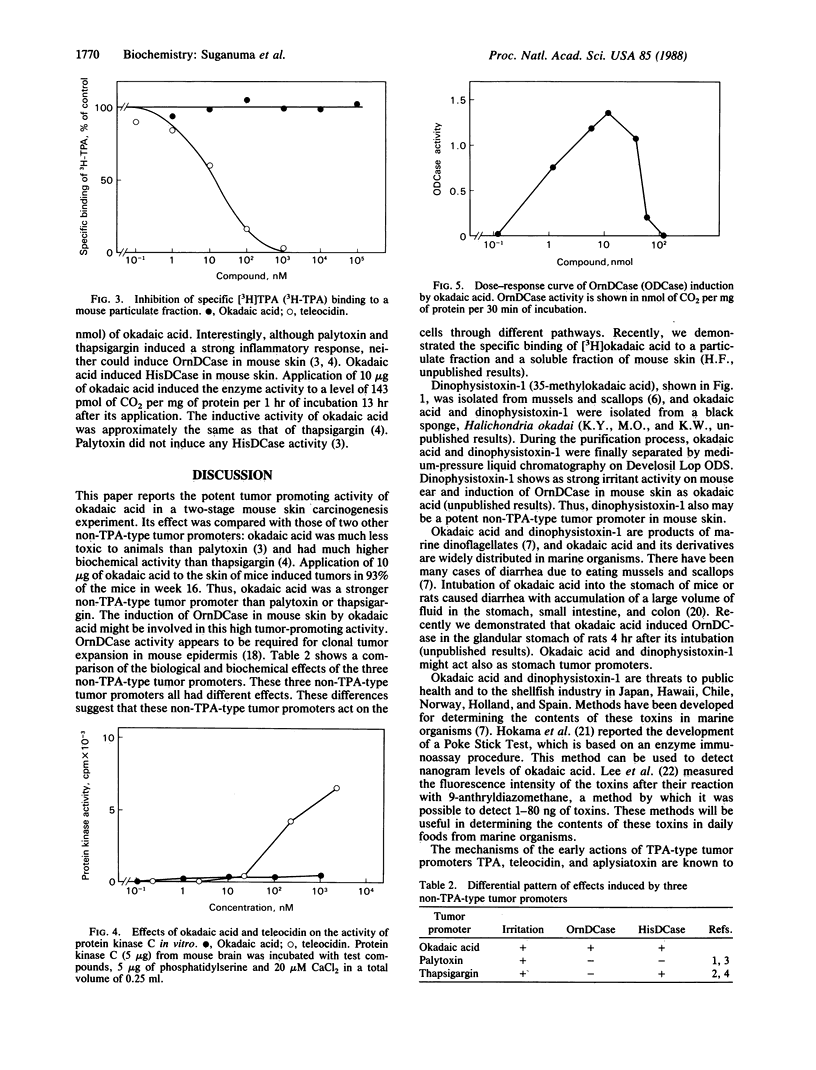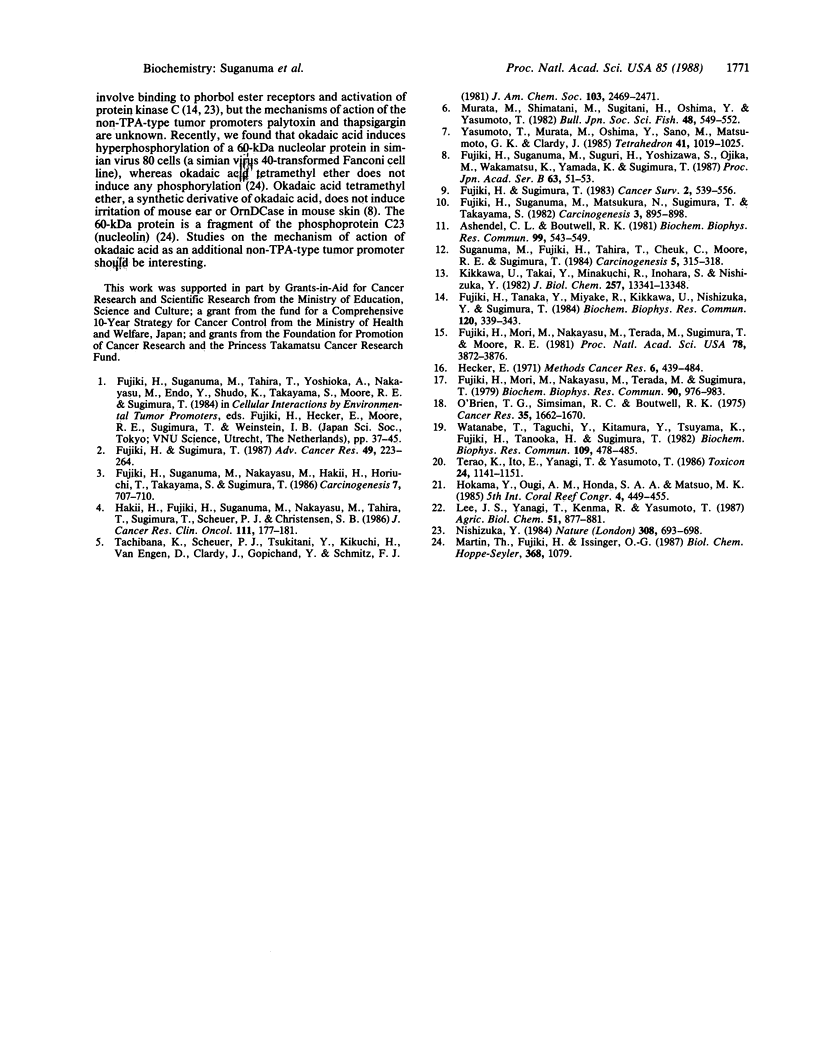Abstract
Okadaic acid is a polyether compound of a C38 fatty acid, isolated from a black sponge, Halichondria okadai. Previous studies showed that okadaic acid is a skin irritant and induces ornithine decarboxylase (OrnDCase; 3-hydroxyl-L-glutamate 1-carboxy-lyase, EC 4.1.1.17) in mouse skin 4 hr after its application to the skin. This induction was strongly inhibited by pretreatment of the skin with 13-cis-retinoic acid. A two-stage carcinogenesis experiment in mouse skin initiated by a single application of 100 micrograms of 7,12-dimethylbenz[a]anthracene (DMBA) and followed by application of 10 micrograms of okadaic acid twice a week revealed that okadaic acid is a potent additional tumor promoter: tumors developed in 93% of the mice treated with DMBA and okadaic acid by week 16. In contrast, tumors were found in only one mouse each in the groups treated with DMBA alone or okadaic acid alone. An average of 2.6 tumors per mouse was found in week 30 in the group treated with DMBA and okadaic acid. Unlike phorbol 12-tetradecanoate 13-acetate (TPA), teleocidin, and aplysiatoxin, okadaic acid did not inhibit the specific binding of [3H]TPA to a mouse skin particulate fraction when added up to 100 microM or activate calcium-activated, phospholipid-dependent protein kinase (protein kinase C) in vitro when added up to 1.2 microM. Therefore, the actions of okadaic acid and phorbol ester may be mediated in different ways. These results show that okadaic acid is a non-TPA-type tumor promoter in mouse skin carcinogenesis.
Full text
PDF



Selected References
These references are in PubMed. This may not be the complete list of references from this article.
- Ashendel C. L., Boutwell R. K. Direct measurement of specific binding of highly lipophilic phorbol diester to mouse epidermal membranes using cold acetone. Biochem Biophys Res Commun. 1981 Mar 31;99(2):543–549. doi: 10.1016/0006-291x(81)91779-4. [DOI] [PubMed] [Google Scholar]
- Fujiki H., Mori M., Nakayasu M., Terada M., Sugimura T. A possible naturally occurring tumor promoter, teleocidin B from Streptomyces. Biochem Biophys Res Commun. 1979 Oct 12;90(3):976–983. doi: 10.1016/0006-291x(79)91923-5. [DOI] [PubMed] [Google Scholar]
- Fujiki H., Mori M., Nakayasu M., Terada M., Sugimura T., Moore R. E. Indole alkaloids: dihydroteleocidin B, teleocidin, and lyngbyatoxin A as members of a new class of tumor promoters. Proc Natl Acad Sci U S A. 1981 Jun;78(6):3872–3876. doi: 10.1073/pnas.78.6.3872. [DOI] [PMC free article] [PubMed] [Google Scholar]
- Fujiki H., Suganuma M., Matsukura N., Sugimura T., Takayama S. Teleocidin from Streptomyces is a potent promoter of mouse skin carcinogenesis. Carcinogenesis. 1982;3(8):895–898. doi: 10.1093/carcin/3.8.895. [DOI] [PubMed] [Google Scholar]
- Fujiki H., Suganuma M., Nakayasu M., Hakii H., Horiuchi T., Takayama S., Sugimura T. Palytoxin is a non-12-O-tetradecanoylphorbol-13-acetate type tumor promoter in two-stage mouse skin carcinogenesis. Carcinogenesis. 1986 May;7(5):707–710. doi: 10.1093/carcin/7.5.707. [DOI] [PubMed] [Google Scholar]
- Fujiki H., Sugimura T. New classes of tumor promoters: teleocidin, aplysiatoxin, and palytoxin. Adv Cancer Res. 1987;49:223–264. doi: 10.1016/s0065-230x(08)60799-x. [DOI] [PubMed] [Google Scholar]
- Fujiki H., Tanaka Y., Miyake R., Kikkawa U., Nishizuka Y., Sugimura T. Activation of calcium-activated, phospholipid-dependent protein kinase (protein kinase C) by new classes of tumor promoters: teleocidin and debromoaplysiatoxin. Biochem Biophys Res Commun. 1984 Apr 30;120(2):339–343. doi: 10.1016/0006-291x(84)91259-2. [DOI] [PubMed] [Google Scholar]
- Hakii H., Fujiki H., Suganuma M., Nakayasu M., Tahira T., Sugimura T., Scheuer P. J., Christensen S. B. Thapsigargin, a histamine secretagogue, is a non-12-O-tetradecanoylphorbol-13-acetate (TPA) type tumor promoter in two-stage mouse skin carcinogenesis. J Cancer Res Clin Oncol. 1986;111(3):177–181. doi: 10.1007/BF00389230. [DOI] [PMC free article] [PubMed] [Google Scholar]
- Kikkawa U., Takai Y., Minakuchi R., Inohara S., Nishizuka Y. Calcium-activated, phospholipid-dependent protein kinase from rat brain. Subcellular distribution, purification, and properties. J Biol Chem. 1982 Nov 25;257(22):13341–13348. [PubMed] [Google Scholar]
- Nishizuka Y. The role of protein kinase C in cell surface signal transduction and tumour promotion. Nature. 1984 Apr 19;308(5961):693–698. doi: 10.1038/308693a0. [DOI] [PubMed] [Google Scholar]
- O'Brien T. G., Simsiman R. C., Boutwell R. K. Induction of the polyamine-biosynthetic enzymes in mouse epidermis by tumor-promoting agents. Cancer Res. 1975 Jul;35(7):1662–1670. [PubMed] [Google Scholar]
- Suganuma M., Fujiki H., Tahira T., Cheuk C., Moore R. E., Sugimura T. Estimation of tumor promoting activity and structure-function relationships of aplysiatoxins. Carcinogenesis. 1984 Mar;5(3):315–318. doi: 10.1093/carcin/5.3.315. [DOI] [PubMed] [Google Scholar]
- Terao K., Ito E., Yanagi T., Yasumoto T. Histopathological studies on experimental marine toxin poisoning. I. Ultrastructural changes in the small intestine and liver of suckling mice induced by dinophysistoxin-1 and pectenotoxin-1. Toxicon. 1986;24(11-12):1141–1151. doi: 10.1016/0041-0101(86)90140-6. [DOI] [PubMed] [Google Scholar]
- Watanabe T., Taguchi Y., Kitamura Y., Tsuyama K., Fujiki H., Tanooka H., Sugimura T. Induction of histidine decarboxylase activity in mouse skin after application of indole alkaloids, a new class of tumor promoter. Biochem Biophys Res Commun. 1982 Nov 30;109(2):478–485. doi: 10.1016/0006-291x(82)91746-6. [DOI] [PubMed] [Google Scholar]


